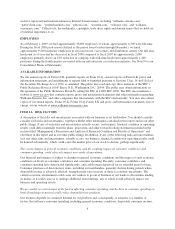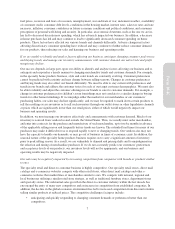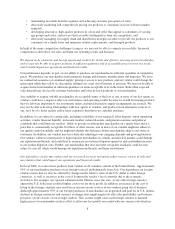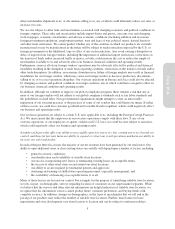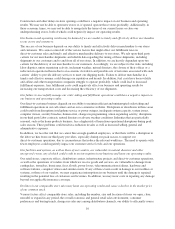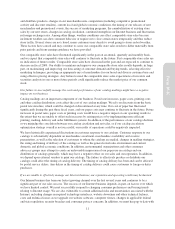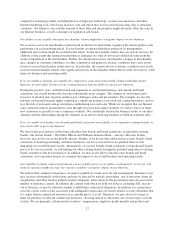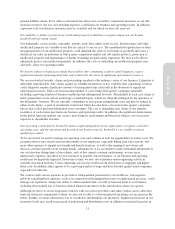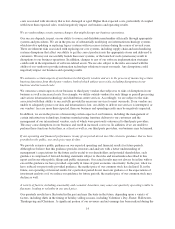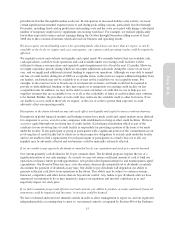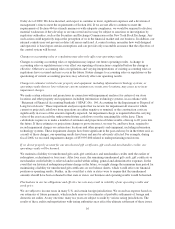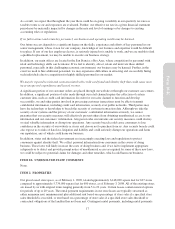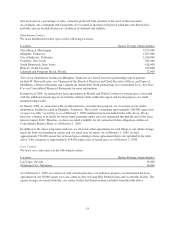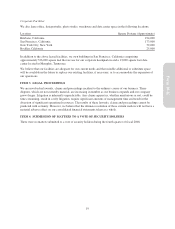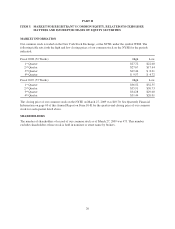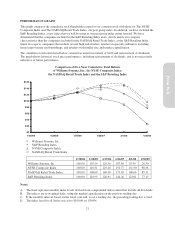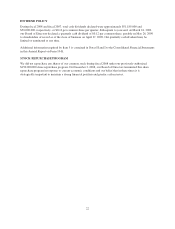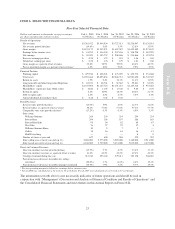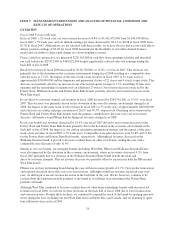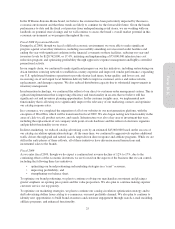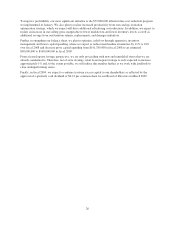Pottery Barn 2008 Annual Report Download - page 28
Download and view the complete annual report
Please find page 28 of the 2008 Pottery Barn annual report below. You can navigate through the pages in the report by either clicking on the pages listed below, or by using the keyword search tool below to find specific information within the annual report.Oxley Act of 2002. We have incurred, and expect to continue to incur, significant expenses and a diversion of
management’s time to meet the requirements of Section 404. If we are not able to continue to meet the
requirements of Section 404 in a timely manner or with adequate compliance, we would be required to disclose
material weaknesses if they develop or are uncovered and we may be subject to sanctions or investigation by
regulatory authorities, such as the Securities and Exchange Commission or the New York Stock Exchange. Any
such action could negatively impact the perception of us in the financial market and our business. In addition, our
internal controls may not prevent or detect all errors and fraud. A control system, no matter how well designed
and operated, is based upon certain assumptions and can provide only reasonable assurance that the objectives of
the control system will be met.
Changes to accounting rules or regulations may adversely affect our operating results.
Changes to existing accounting rules or regulations may impact our future operating results. A change in
accounting rules or regulations may even affect our reporting of transactions completed before the change is
effective. Other new accounting rules or regulations and varying interpretations of existing accounting rules or
regulations have occurred and may occur in the future. Future changes to accounting rules or regulations or the
questioning of current accounting practices may adversely affect our operating results.
Changes to estimates related to our property and equipment, including information technology systems, or
operating results that are lower than our current estimates at certain store locations, may cause us to incur
impairment charges.
We make certain estimates and projections in connection with impairment analyses for certain of our store
locations and other property and equipment, including information technology systems, in accordance with
“Statement of Financial Accounting Standards (“SFAS”) No. 144, Accounting for the Impairment or Disposal of
Long-Lived Assets.” These impairment analyses require that we review for impairment all stores for which
current or projected cash flows from operations are either negative or nominal, or the construction costs are
significantly in excess of the amount originally expected. An impairment charge is required when the carrying
value of the asset exceeds the undiscounted future cash flows over the remaining life of the lease. These
calculations require us to make a number of estimates and projections of future results, often up to 20 years into
the future. If these estimates or projections change or prove incorrect, we may be, and have been, required to
record impairment charges on certain store locations and other property and equipment, including information
technology systems. These impairment charges have been significant in the past and may be in the future and, as
a result of these charges, our operating results have been and may be adversely affected. For example, during
fiscal 2008, we recorded impairment charges of $33,995,000 related to underperforming retail stores.
If we do not properly account for our unredeemed gift certificates, gift cards and merchandise credits, our
operating results will be harmed.
We maintain a liability for unredeemed gift cards, gift certificates and merchandise credits until the earlier of
redemption, escheatment or four years. After four years, the remaining unredeemed gift cards, gift certificate or
merchandise credit liability is relieved and recorded within selling, general and administrative expenses. In the
event that our historical redemption patterns change in the future, we might change the minimum time period for
maintaining a liability for unredeemed gift certificates on our balance sheets, which would affect our financial
position or operating results. Further, in the event that a state or states were to require that the unredeemed
amounts should have been escheated to that state or states, our business and operating results would be harmed.
Fluctuations in our tax obligations and effective tax rate may result in volatility of our operating results and
stock price.
We are subject to income taxes in many U.S. and certain foreign jurisdictions. We record tax expense based on
our estimates of future payments, which include reserves for estimates of probable settlements of foreign and
domestic tax audits. At any one time, many tax years are subject to audit by various taxing jurisdictions. The
results of these audits and negotiations with taxing authorities may affect the ultimate settlement of these issues.
16


